Color has become one of the most powerful tools in kitchen design. It's no longer just a backdrop—it's a statement. In 2025, modern kitchens are seeing a shift toward colors that feel grounded, calming, and quietly confident. From soft neutrals to earthy greens, the palette reflects a broader movement toward personalized, natural living environments. Below are seven modern kitchen cabinet colors that are leading the way this year, each offering a distinct feel without compromising on contemporary appeal. These colors are not just about aesthetics—they're about shaping how a space feels and functions, day in and day out.
Matte white remains a foundational color in modern kitchen design. It's clean, soft on the eyes, and highly adaptable. Unlike glossy white, which can feel clinical, matte white brings warmth and depth while still delivering that fresh, airy aesthetic many homeowners seek. It's particularly appreciated in urban homes or small apartments, where a light palette can make compact spaces feel more expansive and serene.
In open-concept layouts, matte white cabinetry reflects light without overwhelming glare. It works beautifully with oak flooring, quartz countertops, and brushed metal fixtures. For homeowners considering a timeless option, white cabinet kitchen layouts remain a top contender—simple, elegant, and versatile. This combination enhances the continuity between kitchen and living areas, making the design flow naturally in open spaces.
This color also enhances minimalist and Scandinavian aesthetics. Its neutral tone doesn't compete with textures or architectural lines, making it ideal for spaces where flow and balance are essential. Matte finishes are easier to maintain than glossy ones, hiding fingerprints and light scratches better. This makes matte white an ideal choice for busy households who want both form and function. For long-term practicality and visual longevity, few options beat the understated elegance of matte white.
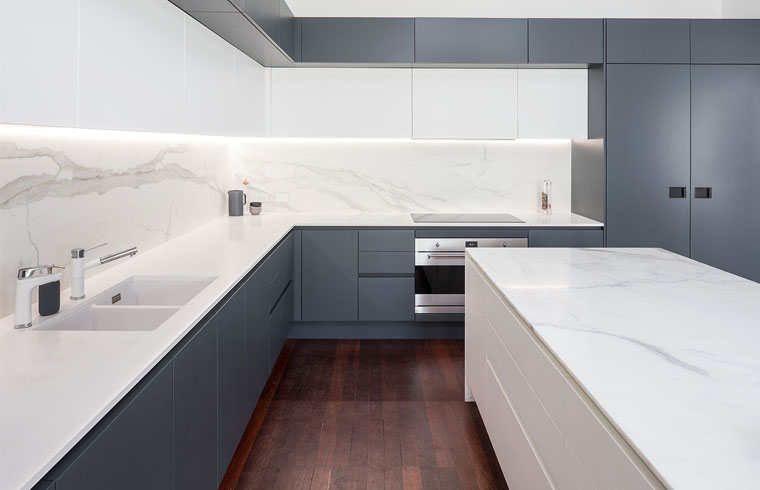
Greige—a blend of gray and beige—continues its rise as a top neutral. Today's greige tones lean warmer, offering coziness with polish. It pairs easily with stone backsplashes, pale flooring, and patterned tiles.
This color harmonizes with varied design styles, especially when used in kitchen counter and cabinets layouts. It helps define the space while staying understated, adapting beautifully to shifting light throughout the day.
Its chameleon-like quality means it's compatible with both warm and cool palettes. Greige cabinets work well with wood accents, brushed gold fixtures, or matte black pulls. For contemporary kitchens that need warmth without color, greige provides a perfect solution. It can also soften harder surfaces like stainless steel appliances or concrete countertops, adding a welcoming tone.
Greige also creates a smooth transition between open kitchen areas and adjacent spaces like dining or living rooms. Its neutrality lets other elements shine—whether it's a statement light fixture or patterned backsplash—without clashing. That's why designers often describe greige as the “quiet luxury” of kitchen colors: subtle, elegant, and enduring.
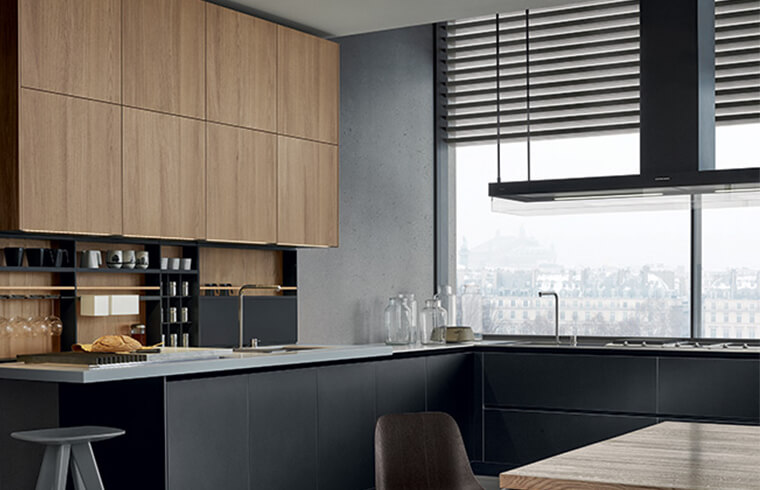
Charcoal and matte black are making bold statements in modern kitchens. These shades offer a sense of sophistication without overwhelming the space. Handle-less doors and clean edges give dark cabinetry a sleek, architectural feel.
In spaces with ample daylight, black kitchen cabinets become a defining feature—striking yet grounded. Paired with light countertops or gold fixtures, they add high contrast and a sense of modern drama.
Charcoal provides a slightly softened effect, ideal for those who find black too intense. Both colors work exceptionally well with open shelving or accent walls in wood or textured tile. In high-end kitchens, combining black cabinets with waterfall marble islands or backlit cabinetry elevates the look to something truly custom.
Dark cabinetry also allows for bold design experiments. Homeowners can incorporate sculptural range hoods, oversized hardware, or moody accent walls without the kitchen feeling chaotic. When complemented with smart lighting design—like undercabinet strips or recessed LEDs—black and charcoal kitchens achieve the perfect balance between intimacy and clarity.
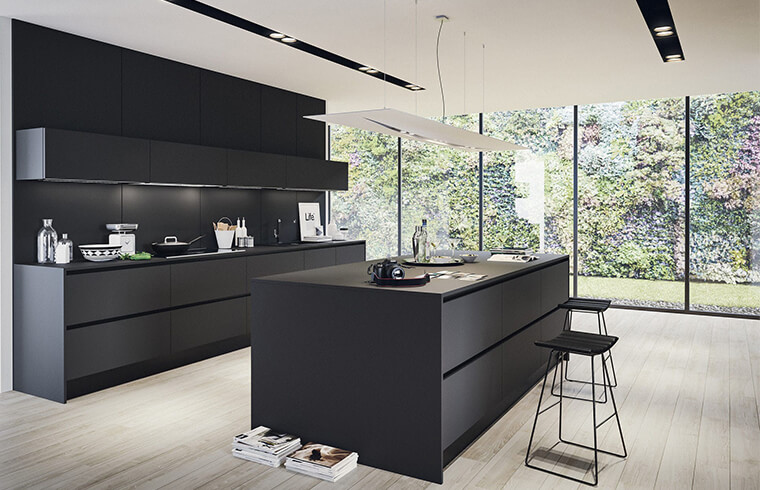
Natural wood is having a strong resurgence in modern design. Today's preferences lean toward lighter species like white oak, ash, and birch—tones that feel natural, warm, and approachable.
Natural wood kitchen cabinets bring texture and authenticity to sleek kitchens. Flat panels with visible grain lines enhance tactile appeal, while mixed finishes (like combining wood with white or black) create layered visual interest.
Designers often use natural wood cabinetry to soften hard lines in modern layouts. Its organic texture adds a grounding element, especially when contrasted with polished surfaces like quartz or steel. As sustainability becomes a priority, many homeowners are also seeking FSC-certified materials and natural oil finishes, reinforcing their commitment to eco-conscious living.
Wood cabinetry also introduces a biophilic element to kitchen interiors. It mimics nature's irregularities, helping us feel more at ease in our environments. In small kitchens, lighter wood finishes can expand the sense of space. In larger layouts, combining wood cabinets with floating open shelves offers visual rhythm and open sightlines.
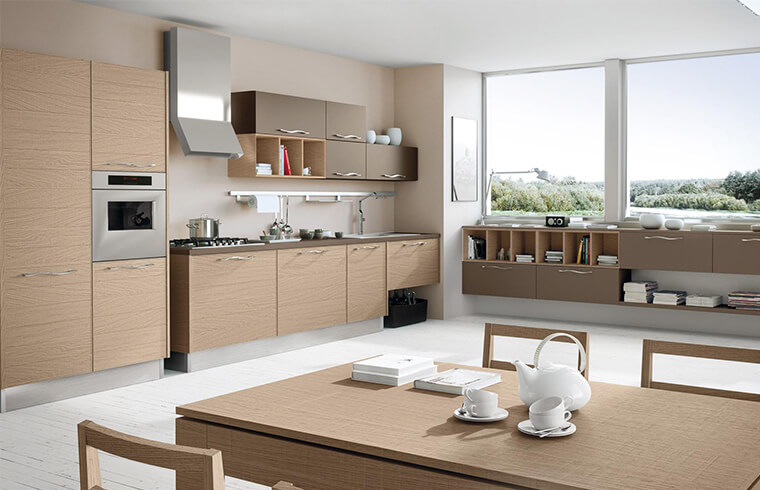
Olive green strikes a balance between color and calm. It's grounded, natural, and increasingly popular in contemporary kitchens. Often used on base cabinets or islands, olive tones add character without overpowering the space.
Pairing green cabinets kitchen designs with wood, brass, or textured ceramics helps achieve a timeless, nature-forward atmosphere—especially in homes with indoor-outdoor flow.
Olive green is also versatile enough to suit both traditional and contemporary settings. It pairs especially well with creamy countertops, walnut open shelves, or concrete floors. As part of a biophilic design strategy, olive cabinetry contributes to a kitchen that feels peaceful and connected to the outdoors.
This tone works well with matte finishes, linen textures, and handmade tiles, giving kitchens a curated, high-design feel. For color lovers who are cautious about commitment, olive is a smart compromise—rich, but restrained; warm, yet neutral enough to stand the test of time.

Navy offers depth and richness without the starkness of black. It's adaptable across design styles—coastal, classic, or modern. Navy is especially effective for islands or base cabinets that anchor a light-toned kitchen.
For those who want character with practicality, navy cabinets kitchen choices are ideal. They conceal wear and work beautifully with a range of hardware and countertop materials.
Designers often use navy to create a tailored, high-contrast aesthetic—particularly when paired with white walls, brass lighting, or natural wood. It's a popular color in open-concept spaces where the kitchen needs to feel defined but not disconnected. Navy also responds beautifully to lighting changes, adding dimension and elegance at all times of day.
Unlike true black, navy invites complementary hues—like terracotta, mustard, or coral—into the palette. It serves as both a grounding base and a bridge to more expressive elements, making it a designer's favorite for kitchens that aim to feel both dynamic and anchored.
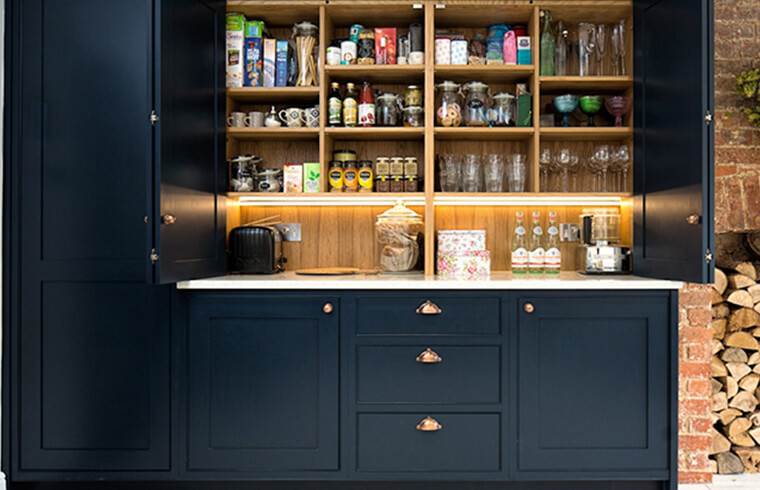
Two-tone cabinetry remains a popular way to introduce visual interest without overwhelming the space. Common combinations include white uppers with darker bases, or wood tones paired with soft hues.
A key to success is simplicity: clean finishes, consistent hardware, and flat surfaces. Using flat panel kitchen cabinets helps keep the look unified and contemporary, no matter the color combination.
The two-tone approach also adds flexibility to long-term design. Homeowners can refresh one section later—such as updating only the island—with minimal disruption. It's especially effective in multifunctional spaces, like kitchens that connect to living or dining areas, where visual variation helps define zones while preserving cohesion.
Two-tone kitchens also support contrast in finishes—pairing matte surfaces with polished stone or metallic hardware. When executed well, this layered strategy introduces dimension and personalization to the most functional space in the home.
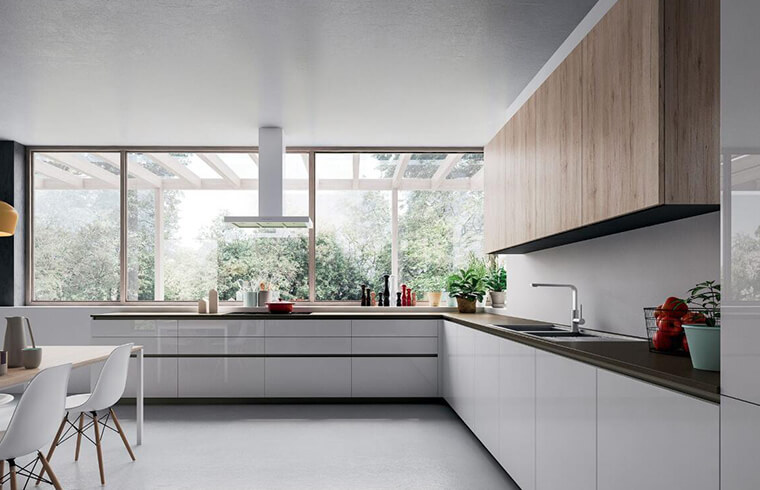
While it's tempting to follow trends, the most successful kitchen designs are built on personal preference and spatial awareness. Here are a few guidelines to help navigate the process:
If your kitchen gets limited sunlight, lighter tones like matte white or greige can help brighten the space. Conversely, darker hues work well in light-filled rooms where they won't feel too heavy.
Families with kids or pets might lean toward mid-tones or wood grains that are more forgiving when it comes to fingerprints and scuffs. Matte finishes are also easier to keep looking clean.
Calm, spa-like kitchens often use greens and beiges, while dramatic or architectural spaces benefit from deep blues and blacks. Think about how you want the space to feel every time you walk in.
Your cabinet color should harmonize with countertops, backsplash, flooring, and even light fixtures. Creating a mood board or using a cabinet door sample can be helpful. Be mindful of undertones—cool grays and warm taupes don't always mix well.
If you're unsure about committing to a full kitchen color, try using it on a smaller area first—like the island, pantry wall, or open shelves. Color accents can be enough to shift the entire atmosphere.
In 2025, modern kitchen cabinet colors are less about standing out and more about fitting in—into the lives, moods, and rhythms of the people who live there. Whether you're drawn to the calm clarity of matte white, the quiet strength of charcoal, or the natural grounding of olive green, the right color can transform not just your cabinets, but how your kitchen feels.
BFP Cabinetry offers a curated selection of contemporary cabinet finishes that reflect these trends while supporting functional, timeless design. From rich wood tones to confident two-tone combinations, their product lines are tailored for modern living with elegance and flexibility.
Want to explore custom kitchen cabinet solutions? Email us or visit www.bfpcabinetry.com.
We employ cookies to analyze website traffic and enhance your browsing experience. Data securely aggregated, privacy protected. See Privacy Policy for details.